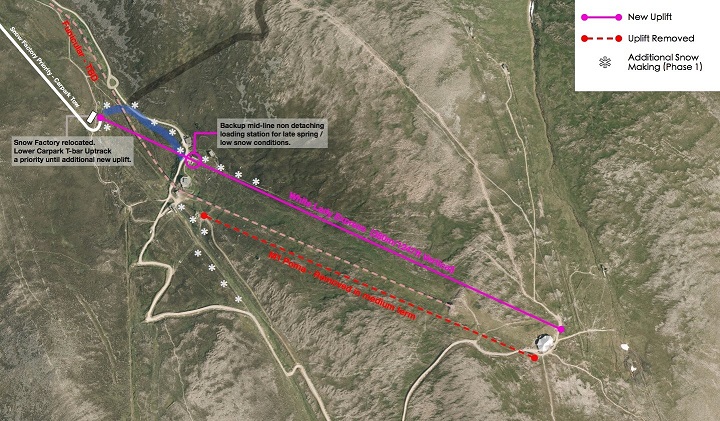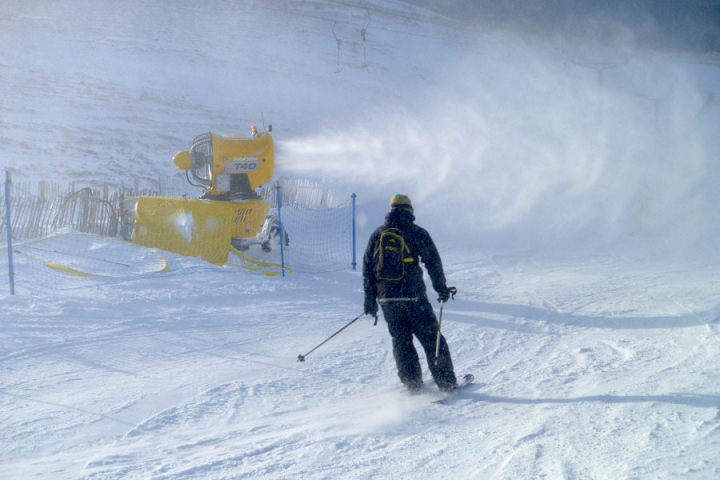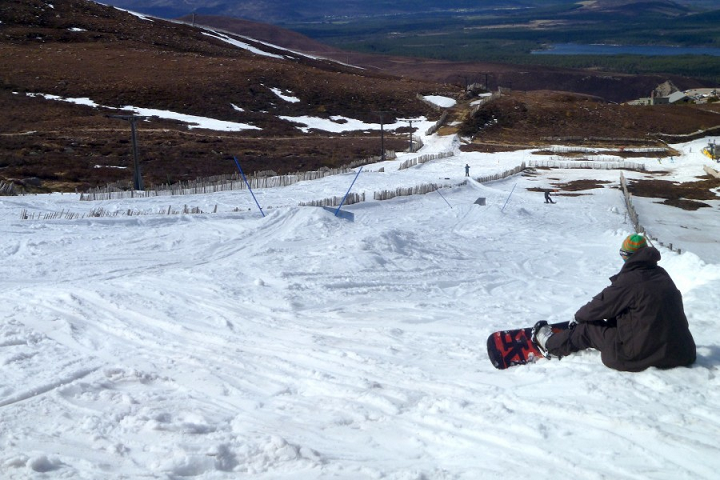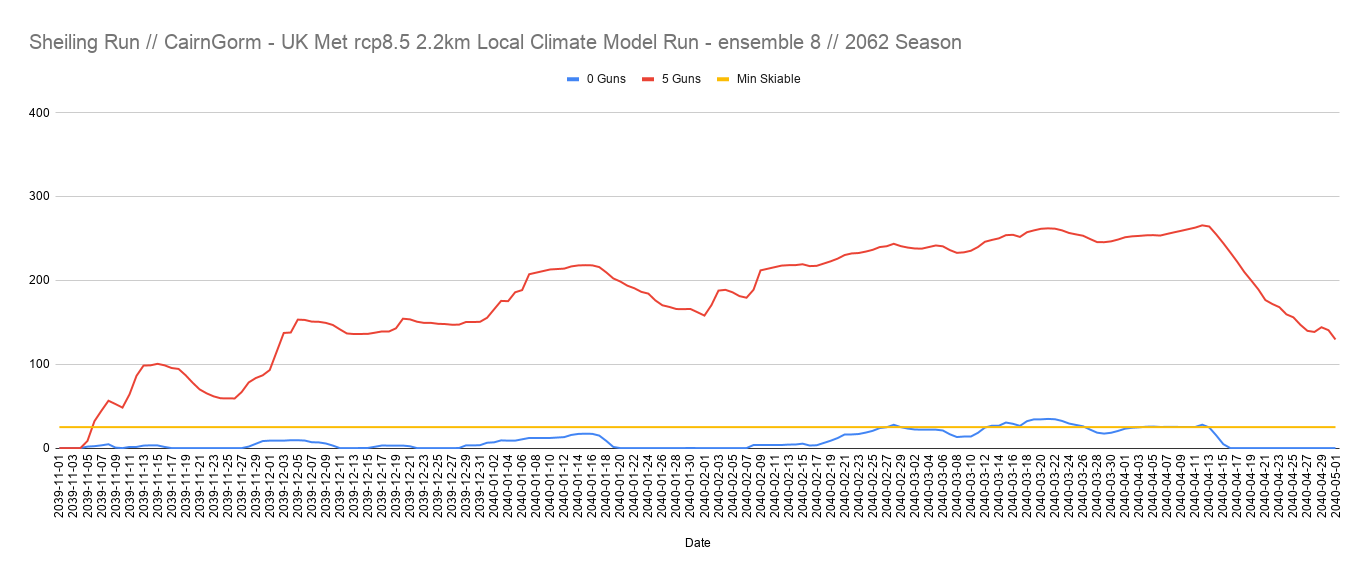PROPOSAL
(For the first in this series of four posts on wintersports alternatives to the funicular see here).
A new high speed detachable express chairlift close to the alignment of the former White Lady T-bar and extending downslope to near the foot of the Sheiling Rope Tow, with installed snow making on upper Home Road and Sheiling Run.
CONSTRAINTS
The White Lady is an FIS (International Ski Federation) homologated (approved) race piste. Thus to maintain the homologation as well as maintain quality of the run for recreational riders lift towers must be kept clear of the piste. It is doubtful if the SE Group’s proposals produced for Highlands and Island Enterprise would fit with this requirement.
The increasing exposure of the terrain as one moves up the mountain is a factor tending to favour the former T-bar line. It is inadvisable to extend above the Top Station on such an alignment due to the rapidly increasing exposure of the slopes immediately above the Ptarmigan Restaurant. The SE Group proposed a top terminal high above Coronation Wall that would serve both it and the Marquis Well. Such a lift line would be hugely more exposed than any already existing on Cairn Gorm and would be able to operate on substantially fewer days than a lift on the line of the former White Lady T-bar topping out by the Ptarmigan Restaurant.
The Ptarmigan Restaurant and recently extended West Wall Poma leave very limited options for the top terminal of a new lift. There are thus two basic route concepts for a new White Lady Chairlift, broadly following either the former T-bar or Chairlift. However the funicular structure and tunnel present a significant constraint to timely construction on the former chairlift corridor. Further, the old chairlift drive station site does not serve the full length of the White Lady Run.
The proposal detailed below is thus for a new chairlift on the line of the former T-bar.
DETAILS
Ideally this lift would be a 6 seater for increased wind stability, however it might be possible to install a quad chair quicker. A 6 seater chair with careful tower placement should achieve an operating wind limit of 55 to 60mph.
 This lift should be detachable, it is the longest of the 3 projects described here at 1320m. Plus at least in the short to medium term it would serve as not just a lift for all snowsports abilities (including first time novices being taken to the Ptarmigan Bowl), but also serve paying sightseeing visitors to the Ptarmigan Restaurant. This would also allow the carriers to be removed from the line when severe conditions are expected, allowing a quicker reopening and preventing damage to the installation.
This lift should be detachable, it is the longest of the 3 projects described here at 1320m. Plus at least in the short to medium term it would serve as not just a lift for all snowsports abilities (including first time novices being taken to the Ptarmigan Bowl), but also serve paying sightseeing visitors to the Ptarmigan Restaurant. This would also allow the carriers to be removed from the line when severe conditions are expected, allowing a quicker reopening and preventing damage to the installation.
It is proposed to extend down-slope from the former White Lady T-bar drive to near the foot of the Sheiling Rope Tow and run. There are several reasons for proposing this:
- It allows the full length of the White Lady snow field to be skied.
- A detachable chairlift drive station requires considerably more space than the former T-bar: the proposed location will give a bigger flat circulation area at the base of the lift.
- A gentler approach, as the chair is for all abilities, serving green to black terrain.
- It avoids disturbance to established montane scrub below the Scottish Ski Club hut.
- It allows Jean’s Bowl, the full length of the former Fiacaill T-bar runs and a proposed black fenced run from the M2 to Home Road to be served by the new lift.
- Snow Making modelling indicates an automated installed system will sustain the extension throughout the bulk of most seasons (into the foreseeable future).
- Re-positioning, for the medium term, the TechnAlpin Snowfactory adjacent to the base of the new lift would allow snow to be pushed snow down the lower half of the Carpark T-bar for skier / snowboard access.
- It provides a location where it is also practical to shuttle non-skiers and novices via a resurfaced Home Road to level with the base of the lift. This could be via an electric road train type vehicle.
As phase 1 of a new snow making system, fixed hydrants and power supply (if required) should be put in place on the lower third of the White Lady, Cas Gunbarrel and by the Home Road to the foot of the Sheiling Tow. This would be in addition to cannons on the Sheiling Run itself.
A fenced shortcut for the top of the Home Road (blue route on map) should be considered as this would divert the increased ski traffic from the immediate vicinity of the Kassbohrer garage.

Modelling showing a modern installed snow making system could sustain the Sheiling Run later in the season was validated by the placement of 3 fan guns on the Sheiling Run through a significant portion of the 2013 season.

It is of course a legitimate question to ask, ‘snow making may have sustained the approaches to the proposed lift station in the recent past, but what about 10 years time, what about 20 years time or beyond’ given the hoped for life expectancy of the lift equipment.
Scottish Snowsports have always been opportunistic in nature subject to wide natural variability both intra-season and from season to season. We have experienced seasons in the past that climate models indicate would still be notably poor seasons well into the future such is the scale of that natural variability. Indeed the biggest mountain snow season of the 2007 to 2018 period was the winter 2013/14 which was 0.7ºc warmer than the dire 2011/12 ski season across the Met Office N&E Scotland climate regions.
It is worth noting that the Met Office climate modelling (mesoscale runs of the rcp8.5 (representative concentration pathway) scenario) is able to predict details lost on global and even mid-resolution regional models. Known as the ‘UKCP Convection-permitting model’ these projections are able to account for the inland cooling in the central Highlands in winter. Warming in the UK is focused on Central England in summer with the least warming occurring in the Central Highlands in mid-winter.

UKCP18 Representative Concentration Pathway (RCP) scenarios with lower climate forcing (rcp1.9. 2.6, 4.5 and 6.0) represent lower rates of planet wide warming and would be expected to have lower impacts on snow cover. However, only the ‘worst case’ rcp8.5 scenario has been run with the 2.2km Met Office mesoscale model to date.
Modelling derived from the Met Office mesoscale runs under an rcp8.5 scenario predict that, for the early 2060s, the average number of days the Sheiling Run would be skiable with solely natural snowfall would be 44 days a season, a 40% decline from an observed 70 days from 2007-2018. The Met Office projections indicate natural climate variation remaining a substantial factor, giving a potential spread from 0 to 108 days of natural skiable snow at 2300ft in the early 2060s. By comparison the observed range from 2007 to 2018 was 12 to 126 days.
However with just five air water snow guns, the modelling indicates the Sheiling Run could, on average, remain skiable in the early 2060s for twice as many days as observed over the past decade by natural snow cover.
Given climate models indicate a larger reduction in lying snow than falling snow, with snow cover tending towards being more transitory, this may seem surprising. The climate xchange report for the Cairngorms National Park Authority on snow lie across the national park as a whole projects lying snow days would reduce 3x more than falling snow events under the rcp8.5 scenario.
However one of the key benefits of an installed snowmaking system is that by being able to put down an early season technical base, all subsequent natural snowfall through the season contributes to the base depth, rather than an increasing portion of it melting on warm & wet bare ground.
With modern snow making systems the old rules don’t apply anymore, minimising ablation becomes the more important factor. That means the best terrain in the future may not be at the highest elevations as, though temperatures will on average be colder there, rainfall events will be more intense and wind speeds stronger at the highest elevations.

Leave the M1 Poma. It is essential as a backup.